April 4, 2024

AI receptionists are revolutionizing quick service restaurants by enhancing customer service, reducing wait times, and cutting operational costs. Here's how:
Case studies of Loman AI and IVY demonstrate their impact: Loman AI led to a 35% increase in online orders and $3 million in annual savings for Burger Bots, while IVY improved customer satisfaction to 94% for Eatica. These technologies not only improve efficiency and customer experience but also contribute to significant financial benefits for quick service restaurants.
Burger Bots, a well-loved fast food place known for its tasty burgers and fries, was facing some big problems:
To fix these problems, Burger Bots started using Loman AI's virtual receptionist. Here's why they liked it:
After bringing in Loman AI, Burger Bots saw some great improvements:
By using AI for simple tasks like taking orders and answering common questions, Burger Bots could make things better for both customers and staff. Staff could focus on making food and taking care of customers in the store. Plus, with Loman AI suggesting extra items, orders got bigger.
In the end, Loman AI helped Burger Bots make over $15 million more each year across all its locations, while also improving the experience for everyone involved. This story shows how much of a difference AI virtual receptionists can make in fast food places.
IVY is a smart system that chats with customers using text or voice any time, day or night. It can talk in over 100 languages, making it super helpful for everyone.
Eatica is a restaurant chain that offers healthy meals you can customize. But as they got more popular, they faced some challenges:
Eatica wanted to use technology to make their service better and get ready to grow bigger. That's where IVY came in.
After Eatica started using IVY, things got a lot better:
Also, IVY made sure orders were right more than 95% of the time and cut down waiting by 30%. More customers were happy, with satisfaction scores hitting 94%.
With IVY taking care of the routine stuff, Eatica could make more money and let their staff focus on making food and taking care of guests. Customers got faster service that was just for them, and employees could spend more time on making the dining experience better.
In the end, IVY helped Eatica grow in a smart way, making sure they could keep offering great service as they got bigger.
MetricLoman AIIVYIncrease in Online Orders35%10% Increase in Return CustomersIncrease in Order Value25%15% Increase in Order ValueAnnual Cost Savings$3 million25% Decrease in Staff CostsCustomer Satisfaction20% Fewer Complaints94% Customer Satisfaction
The stories of Loman AI and IVY show us how much AI helpers can change fast food places for the better. By handling simple tasks like taking orders and answering easy questions, these restaurants saw big jumps in how much they sell and how happy their customers are, all while spending less money and making things run smoother.
Loman AI was great at getting more people to order online and convincing them to buy more with suggestions. This helped the restaurant save a lot of money on staff. IVY, on the other hand, made customers come back more often and spend more each time, also helping to cut down on staff costs. Both systems made orders more accurate and customers happier.
These examples show us that using AI can really help quick service restaurants do better. AI can take care of the busy work, letting people focus on making food and looking after customers. It can handle a lot of customers at once, answer questions any time, and make sure orders are right, all without getting tired.
The success of AI helpers tells us that they're going to be a big deal for fast food places. These restaurants need to think about using AI to keep up with what customers want and to run more efficiently. AI can make suggestions that feel personal and handle orders without any mix-ups, doing all this in a way that saves money.
As AI gets better, it might even start running kitchens and serving areas with little to no help from people. But even with all this technology, the human touch is still important for making customers feel welcome. AI can help make things run better, but people will always be needed for that personal connection.
The COVID-19 pandemic made it even clearer that customers like to order without contact and use digital options. AI fits right into this by making ordering easy and safe. As more people use apps and online ordering, AI can help keep them coming back with smart suggestions and easy buying.
Restaurants that start using AI early will be ahead of the game. They can offer better experiences to their customers and run their places more efficiently. The stories of Loman AI and IVY are just the beginning of what AI can do for restaurants as it keeps getting better.
AI receptionists are changing the game for fast-food places by making things run smoother, keeping customers happy, and helping make more money. They handle the routine stuff, so the team can focus on giving great service.
Here's what's great about AI receptionists:
The stories we shared show how big of a difference AI receptionists can make - more money, happier customers, and less spending. As AI gets even better, fast-food places really need to start using these smart helpers to stay ahead and keep customers smiling. Getting an AI receptionist isn't just a nice extra anymore; it's something places need to do to keep up and do well.

Enter your information in the form to receive a call from Loman and place an order like a customer would!